Build a House Room by Room Is the Best
Notes:
This lesson covers the main rooms of a house besides as vocab for some common household objects.
Lesson Procedure:
Warm Up and Maintenance:
Run across our "Warm Upwardly & Wrap Up" page.
New Learning and Exercise:
1. Teach rooms vocab
Earlier course, cut out 6 pictures of household objects from a mag/catalog: 1 for each of the rooms of a house, for example:
bed (for the bedroom), refrigerator (for the kitchen), shower (for the bathroom), TV (for the living room), dining table (for the dining room), flowers (for the garden).
On the lath describe a motion-picture show of a firm, similar to below. Make certain you depict information technology as large as possible to fill the board.
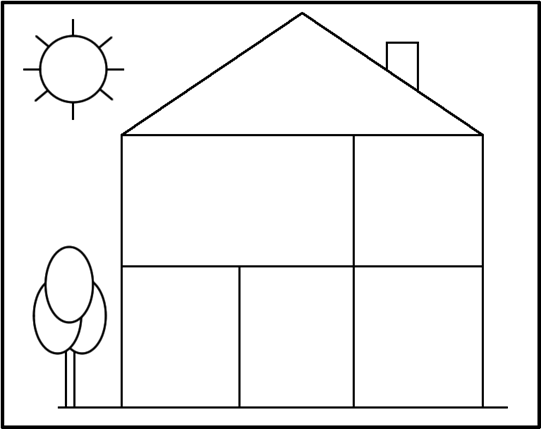
Elicit the words firm, tree and sunday. Yous can also teach/elicit "roof" and "chimney" every bit extra vocab.
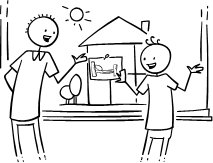 Next, hold upwards the cut out "bed" magazine picture and arm-twist/teach the word. Ask 1 student to come up to the board stick the picture in one of the rooms (make sure it is the large, upstairs room). Practise the same with the other five pictures, each fourth dimension eliciting the discussion and getting a student to stick on your business firm so that each room has a picture in it (and 1 outside in the garden).
Next, hold upwards the cut out "bed" magazine picture and arm-twist/teach the word. Ask 1 student to come up to the board stick the picture in one of the rooms (make sure it is the large, upstairs room). Practise the same with the other five pictures, each fourth dimension eliciting the discussion and getting a student to stick on your business firm so that each room has a picture in it (and 1 outside in the garden).
Now, elicit/teach the words for rooms of the house and garden: point at the bedroom and ask "What room is this?". If no one knows, say, "Well, it has a bed and it is a room, so it's a ..." and effort and elicit "sleeping room". Then write the discussion in the room and chorus 3 times.
Do a similar thing with the other places, due east.g.
- bathroom: a room with a bath
- living room: a room where we live
- dining room: a room where nosotros eat dinner (dinner room ... dining room)
- kitchen/garden: not compound words so can't teach this style - just teach and chorus.
ii. Play the "Rooms of a firm Quiz"
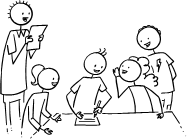 Put your students into groups (of 2-vi students per grouping, depending on how many students are in your course). Get each grouping to elect a team captain and so requite each captain a piece of paper and pencil. Tell the captains to write the numbers 1 to 12 down the left-side of the paper. Each captain is going to write the 12 answers to the quiz questions on this canvass, but the rest of the grouping will help give him/her the answers.
Put your students into groups (of 2-vi students per grouping, depending on how many students are in your course). Get each grouping to elect a team captain and so requite each captain a piece of paper and pencil. Tell the captains to write the numbers 1 to 12 down the left-side of the paper. Each captain is going to write the 12 answers to the quiz questions on this canvass, but the rest of the grouping will help give him/her the answers.
The instructor reads out the following questions every bit the groups write the answers on their sheets:
ane. Where in the house exercise you brush your teeth? (bathroom)
2. Where in the firm practice you cook nutrient? (kitchen)
3. Where in the house do you sleep at dark? (bedroom)
4. Where in the house do you lot eat dinner? (dining room)
5. Where in the house do you lot sit with your family unit and watch TV? (living room)
6. Where do you run across grass? (garden)
7. Where are your books, toys and games (bedroom)
8. Where are the dishes washed? (kitchen)
nine. Where can you sunbathe? (garden)
ten. Where does your family relax together? (living room)
11. Where tin can you get wet within your house? (bathroom)
12. Where is the largest table? (dining room)
Finally, go through the answers with the class by pointing to the right room on your board picture and helping out with any vocab that students don't understand. The winning group gets a round of adulation from everyone.
3. Do "Rooms of a business firm Posters"
Put your students into 6 groups (for smaller classes, 3 groups is fine). Requite each grouping the following:
- i big piece of card / construction paper
- a magazine/itemize with lots of photos of household objects (at to the lowest degree ane per group)
- scissors and glue
 Assign each group a room of a firm (or garden) and go the groups to write the room name at the tiptop of their construction paper. Then, for case, one group volition make a "sleeping accommodation" poster, some other a "living room affiche", etc. If your class is small and you only take 3 groups, each group will take 2 pieces of structure paper (therefore they volition exercise two room posters).
Assign each group a room of a firm (or garden) and go the groups to write the room name at the tiptop of their construction paper. Then, for case, one group volition make a "sleeping accommodation" poster, some other a "living room affiche", etc. If your class is small and you only take 3 groups, each group will take 2 pieces of structure paper (therefore they volition exercise two room posters).
Tell everyone to look through their magazines/catalogs and cut out pictures to stick on their poster for their room. Demonstrate this with 1 room before yous first to make sure everyone understands (east.m. in living room: a sofa, a Tv set, carpeting, coffee tabular array, etc.).
Give students v minutes for this.
 When each grouping has finished, tell anybody that they have to write the words for the things they have stuck on their posters. Having picture dictionaries or even utilize of a computer is ideal for students to find the words. Another alternative is a catalog in English. If you don't have any of these resource, you can assist students with the words they don't know. By the terminate, all of the pictures should be labeled correctly.
When each grouping has finished, tell anybody that they have to write the words for the things they have stuck on their posters. Having picture dictionaries or even utilize of a computer is ideal for students to find the words. Another alternative is a catalog in English. If you don't have any of these resource, you can assist students with the words they don't know. By the terminate, all of the pictures should be labeled correctly.
When all of the posters are complete, get each group to stick theirs to the walls of the classroom - try and go them evenly spaced effectually the room.

4. Play "Touch on the picture"
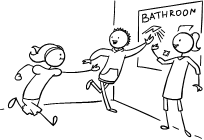 Get everyone to sit in the center of the classroom. Get-go, the teacher goes to each poster and choruses each picture two or 3 times (due east.grand. "bed, bed, bed"). Do this quite quickly to avoid students getting bored. Then, tell everyone that y'all are going to say an object and everyone has to race to touch it on the affiche. The showtime person to touch it is the winner. Shout out a word (due east.thousand. "shower!") and everyone rushes to touch that picture. And so continue shouting out other words, equally students race around the room touching objects on the posters. This should be fast paced and fun.
Get everyone to sit in the center of the classroom. Get-go, the teacher goes to each poster and choruses each picture two or 3 times (due east.grand. "bed, bed, bed"). Do this quite quickly to avoid students getting bored. Then, tell everyone that y'all are going to say an object and everyone has to race to touch it on the affiche. The showtime person to touch it is the winner. Shout out a word (due east.thousand. "shower!") and everyone rushes to touch that picture. And so continue shouting out other words, equally students race around the room touching objects on the posters. This should be fast paced and fun.
5. Play "Touch the picture" in pairs
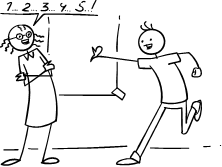 Now, pair up students. Pupil A will say an object from whatsoever poster and Student B has to discover and bear on it. Sounds easy? Well, give a time limit for the students to find and touch the picture (e.1000. 5 seconds - depending on the levels of your students). For case:
Now, pair up students. Pupil A will say an object from whatsoever poster and Student B has to discover and bear on it. Sounds easy? Well, give a time limit for the students to find and touch the picture (e.1000. 5 seconds - depending on the levels of your students). For case:
Student A: Find a lamp! i ... 2 ... 3 ... four ... v ... Time's upwardly!
Pupil B: (runs effectually searching for a lamp picture to touch)
six. Do the "Objects in my house" worksheet
Give out the worksheets. Commencement, become students to write the words for each room on their worksheets. Then become the students to employ the posters effectually the room to write words and draw pictures of the objects they have in their habitation.
 NOTE: If students don't have certain rooms in their homes (east.g. dining room, garden) take them put in objects they take in other rooms that could go in those rooms.
NOTE: If students don't have certain rooms in their homes (east.g. dining room, garden) take them put in objects they take in other rooms that could go in those rooms.
When everyone has finished, put students into pairs. Teach the phase:
Practise you have a/an (sofa)?
or
Have you got a/an (sofa)? (British English)
Then accept pairs ask each other about what they have and don't have in their homes using their worksheets as a guide.
7. Read classroom reader "Mr. Stretch'southward House"
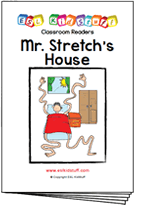 Allow's end with a fun story that practices the vocabulary in today'southward lesson. Before form, download and print off the reader "Mr. Stretch'southward Business firm". As you go through each folio, bespeak to the pictures and elicit the rooms, besides every bit other vocab for the objects in the rooms, for instance:
Allow's end with a fun story that practices the vocabulary in today'southward lesson. Before form, download and print off the reader "Mr. Stretch'southward Business firm". As you go through each folio, bespeak to the pictures and elicit the rooms, besides every bit other vocab for the objects in the rooms, for instance:
Teacher: (pointing at the motion-picture show on page 4) What room is this?
Students: The kitchen!
Teacher: Yes, that's right! What is Mr. Stretch getting?
Students: A assistant!
Teacher: Yeah, good job! He'due south stretching his arm all the way into the kitchen to get a banana! And where is he getting the banana from (pointing at the refrigerator)?
Students: A fridge!
Instructor: Yep, that'due south correct! (Reading) "He is getting a banana from the fridge!". Do you take a fridge in your kitchen, Kate?
Kate: Yep, I do!
Instructor: And do you have bananas in your refrigerator?
Kate: Um, no.
Teacher: Kate doesn't have bananas in her refrigerator. Does any here have bananas in their refrigerator?
David: Yes, I do!
Teacher: Ah, David does! What other nutrient is in your fridge?
David: Um. Ham and eggs and milk.
Instructor: Very skillful, David! Ok, everyone, what else is in Mr. Stretch's kitchen?
Students: A cooker!
etc.
 Go the students actually involved in the story past request lots of questions nigh the what objects they have in their homes.
Go the students actually involved in the story past request lots of questions nigh the what objects they have in their homes.
Subsequently reading the story, give out a reader worksheet to each student and read through the story 1 more time (without stopping for questions, etc.) as students lucifer the objects in the story to the different rooms. Then go through the answers as a class.
---
Alternatively, watch our video version of the reader (Internet connection required):
Wrap Up:
one. Assign Homework: "Domicile Plan" worksheet (be sure to model this first by cartoon a plan of your dwelling house).
ii. Wrap up the lesson with some ideas from our "Warm Up & Wrap Upwards" page.
Source: https://www.eslkidstuff.com/lesson-plans/rooms-of-a-house.html
Belum ada Komentar untuk "Build a House Room by Room Is the Best"
Posting Komentar